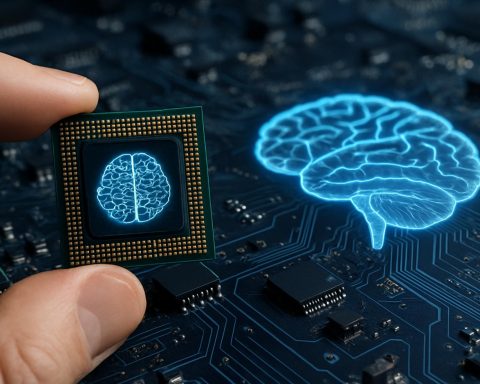- South Korea has invested in 10,000 high-performance GPUs through a public-private collaboration, enhancing its position in the global AI race.
- This strategic acquisition will bolster South Korea’s national AI computing center and stimulate innovation in its technological hubs.
- IBM is transforming the educational experience at Penn State by launching MyResource, an AI-powered student concierge, utilizing its Watsonx platform.
- MyResource aims to provide students with seamless access to academic, wellness, and financial resources.
- Investors seek rapid returns as newer, faster-moving opportunities emerge in the dynamic AI landscape.
- The global AI arena is lively with diverse strategies, as exemplified by South Korea’s significant investment and IBM’s academic initiatives.
- The crucial question in the technological race is which nation or corporation will achieve a breakthrough first.
As nations sprint to claim a stake in the AI race, South Korea has taken a audacious step, announcing the acquisition of 10,000 high-performance GPUs. This move, facilitated by a public-private collaboration, aims to catapult the country into the elite circle of AI powerhouses. The vibrant streets of Seoul and the technological hubs scattered across South Korea are set to buzz with innovation, as these GPUs become the beating heart of their national AI computing center. With AI reshaping global dynamics, South Korea’s strategy represents a masterstroke in not just keeping pace, but also innovating ahead of others.
Across the Pacific, another legacy giant makes headway in academia. International Business Machines (IBM), renowned for its pioneering AI endeavors, is reshaping the experience of nearly 90,000 students at Penn State. Through a partnership utilizing IBM’s renowned Watsonx platform, they’re launching MyResource, an AI-powered student concierge. Imagine a seamlessly navigable world where students effortlessly access academic advising, wellness support, and financial assistance — a digital gateway, designed with precision to complement the rhythms of university life.
Yet not all are content with IBM’s pace. Investors eyeing swift returns quiver with anticipation over other faster-moving opportunities, as the AI landscape crackles with the energy of new entrants.
The global AI chessboard is active — South Korea’s strategic acquisition and IBM’s academic play underscore the varied paths to AI innovation. As nations and corporations forge ahead, the real question remains: who will checkmate first in this era-defining technological race?
Who Will Lead the AI Race? South Korea vs. IBM: Strategies, Trends, and the Future
How-To Steps & Life Hacks
Maximizing AI Investments:
1. Identify Key AI Needs: Assess the specific areas where AI can enhance operations or offer competitive advantages.
2. Develop Partnerships: Collaborate with tech companies or educational institutions for resource sharing and innovation.
3. Scale Infrastructure: Invest in high-performance computing resources, such as GPUs, to support large-scale AI projects.
4. Foster Talent: Develop training programs to bridge the skills gap in AI technology and programming.
5. Stay Agile: Continuously update and adapt AI strategies to keep pace with technological advancements and market needs.
Real-World Use Cases
– South Korea’s GPU Acquisition: The 10,000 GPUs can significantly boost computational power for tasks such as deep learning and big data analytics. This infrastructure might support projects ranging from autonomous vehicles to advanced robotics.
– IBM’s Watsonx in Education: MyResource uses AI to streamline student services by integrating functions that help with academic planning, mental health resources, and financial guidance.
Market Forecasts & Industry Trends
The global AI race is intensifying, with the AI market expected to grow to $407 billion by 2027 (source: Forbes). South Korea’s public-private initiatives set a precedent for other countries, showcasing the benefits of collaborative investment.
Reviews & Comparisons
Industry analysts view South Korea’s GPU acquisition as a valuable step toward achieving self-reliant AI capabilities, while IBM’s educational AI initiatives are praised for their potential to transform and personalize learning experiences.
Controversies & Limitations
Critics warn of potential ethical concerns around data privacy and biased algorithms, both of which are emerging issues in current AI deployment. Furthermore, the pace of innovation could create divides between technologically advanced regions and those lagging.
Features, Specs & Pricing
– South Korea’s AI Infrastructure: The acquisition involves cutting-edge GPUs capable of processing thousands of AI models simultaneously.
– IBM’s Watsonx: This is IBM’s AI platform, noted for its natural language processing capabilities, which can be tailored for various industries beyond education.
Security & Sustainability
Both South Korea’s and IBM’s AI initiatives must prioritize cybersecurity to protect sensitive data. Sustainability remains a priority, with efforts to mitigate the high carbon footprint associated with running large data centers.
Insights & Predictions
Experts predict that countries investing heavily in AI infrastructure will have strategic advantages in emerging tech markets. For organizations, AI investment may dictate industry leadership in sectors such as healthcare, automotive, and finance.
Tutorials & Compatibility
Companies are increasingly offering AI training programs to keep the workforce abreast of new developments. Platforms like Coursera and Udacity provide online courses compatible with varying levels of expertise.
Pros & Cons Overview
Pros:
– Enhanced computational capacities.
– Improved efficiencies and tailored solutions in various sectors.
– Potential for transformational societal impacts.
Cons:
– High costs and potential obsolescence.
– Ethical concerns regarding usage and data management.
– Increasing need for workforce retraining.
Actionable Recommendations
– Invest in Education: Both firms and nations should increase their focus on educating the current and future workforce in AI technologies.
– Public-Private Partnerships: Leverage collaboration for infrastructure developments and resource sharing.
– Monitor Trends: Stay informed on AI market trends and make timely pivots in strategy.
Quick tip: Consider using platforms like IBM for advanced AI solutions and leveraging South Korean innovations as benchmarks in AI development.



















